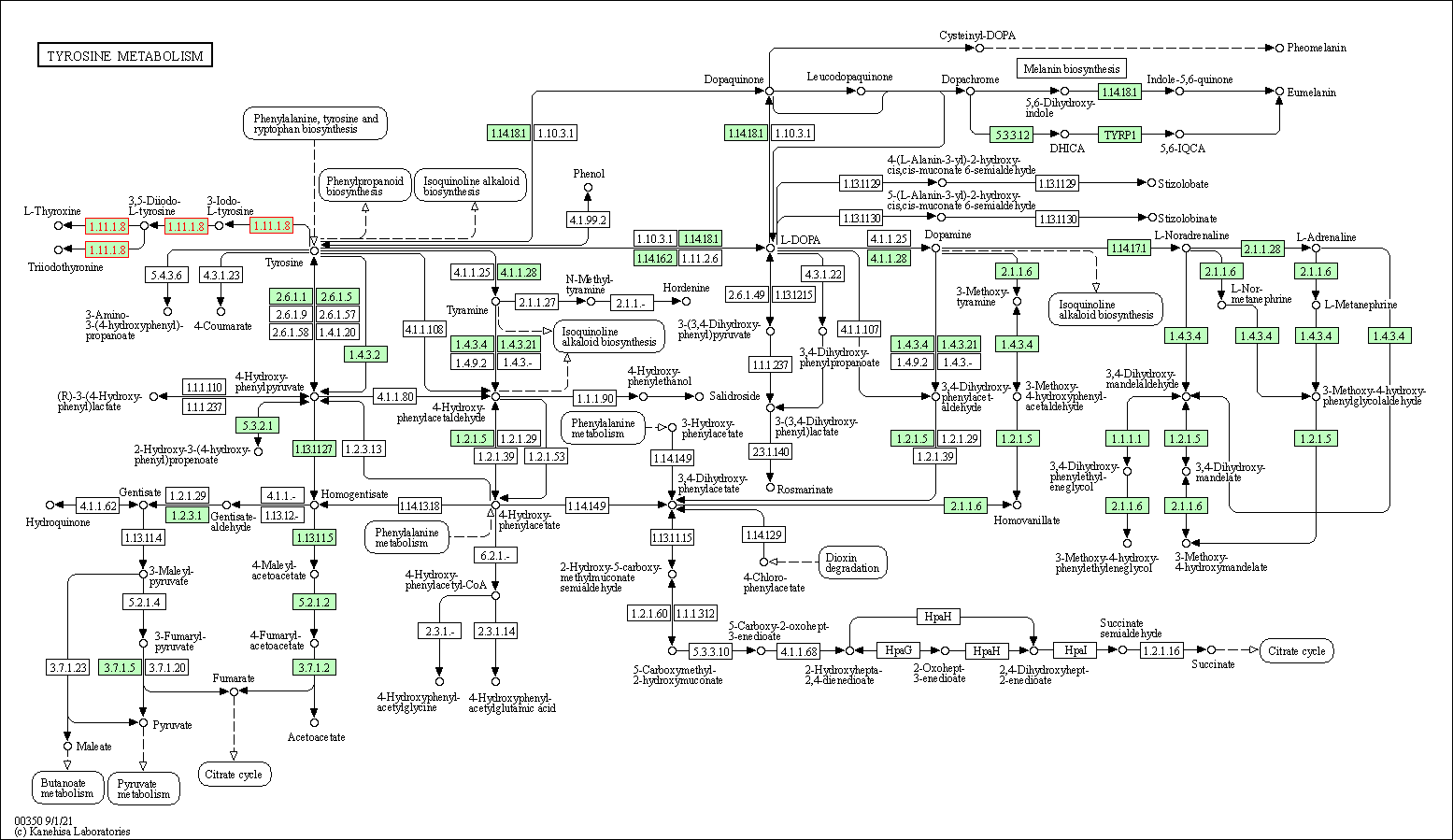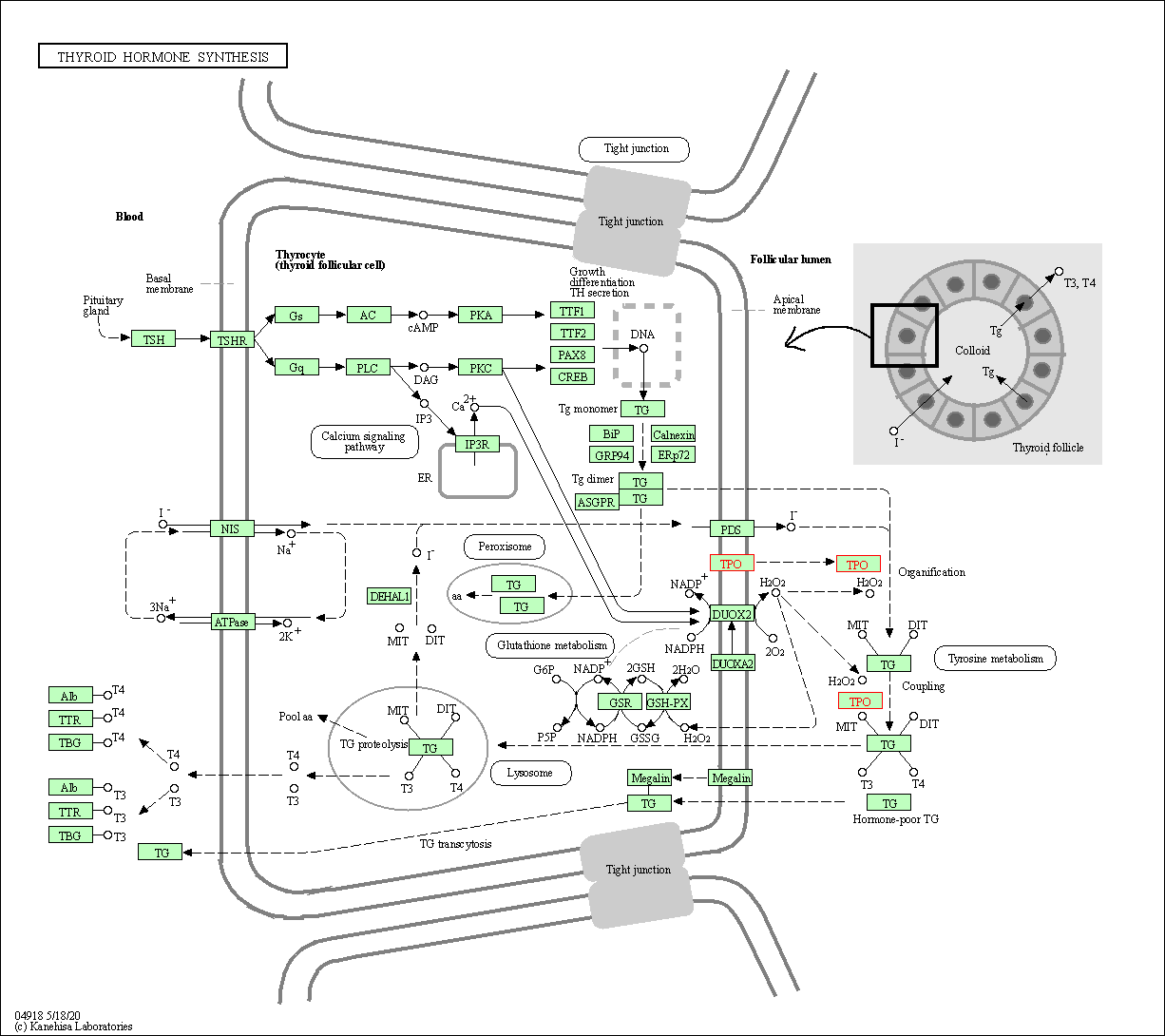Target Information
| Target General Information | Top | |||||
|---|---|---|---|---|---|---|
| Target ID |
T51120
(Former ID: TTDS00380)
|
|||||
| Target Name |
Thyroid peroxidase (TPO)
|
|||||
| Synonyms |
Thyroperoxidase; TPO
Click to Show/Hide
|
|||||
| Gene Name |
TPO
|
|||||
| Target Type |
Successful target
|
[1] | ||||
| Disease | [+] 1 Target-related Diseases | + | ||||
| 1 | Thyrotoxicosis [ICD-11: 5A02] | |||||
| Function |
Iodination and coupling of the hormonogenic tyrosines in thyroglobulin to yield the thyroid hormones T(3) and T(4).
Click to Show/Hide
|
|||||
| BioChemical Class |
Peroxidases
|
|||||
| UniProt ID | ||||||
| EC Number |
EC 1.11.1.8
|
|||||
| Sequence |
MRALAVLSVTLVMACTEAFFPFISRGKELLWGKPEESRVSSVLEESKRLVDTAMYATMQR
NLKKRGILSPAQLLSFSKLPEPTSGVIARAAEIMETSIQAMKRKVNLKTQQSQHPTDALS EDLLSIIANMSGCLPYMLPPKCPNTCLANKYRPITGACNNRDHPRWGASNTALARWLPPV YEDGFSQPRGWNPGFLYNGFPLPPVREVTRHVIQVSNEVVTDDDRYSDLLMAWGQYIDHD IAFTPQSTSKAAFGGGADCQMTCENQNPCFPIQLPEEARPAAGTACLPFYRSSAACGTGD QGALFGNLSTANPRQQMNGLTSFLDASTVYGSSPALERQLRNWTSAEGLLRVHARLRDSG RAYLPFVPPRAPAACAPEPGIPGETRGPCFLAGDGRASEVPSLTALHTLWLREHNRLAAA LKALNAHWSADAVYQEARKVVGALHQIITLRDYIPRILGPEAFQQYVGPYEGYDSTANPT VSNVFSTAAFRFGHATIHPLVRRLDASFQEHPDLPGLWLHQAFFSPWTLLRGGGLDPLIR GLLARPAKLQVQDQLMNEELTERLFVLSNSSTLDLASINLQRGRDHGLPGYNEWREFCGL PRLETPADLSTAIASRSVADKILDLYKHPDNIDVWLGGLAENFLPRARTGPLFACLIGKQ MKALRDGDWFWWENSHVFTDAQRRELEKHSLSRVICDNTGLTRVPMDAFQVGKFPEDFES CDSITGMNLEAWRETFPQDDKCGFPESVENGDFVHCEESGRRVLVYSCRHGYELQGREQL TCTQEGWDFQPPLCKDVNECADGAHPPCHASARCRNTKGGFQCLCADPYELGDDGRTCVD SGRLPRVTWISMSLAALLIGGFAGLTSTVICRWTRTGTKSTLPISETGGGTPELRCGKHQ AVGTSPQRAAAQDSEQESAGMEGRDTHRLPRAL Click to Show/Hide
|
|||||
| 3D Structure | Click to Show 3D Structure of This Target | AlphaFold | ||||
| ADReCS ID | BADD_A04292 ; BADD_A08298 | |||||
| HIT2.0 ID | T36QDK | |||||
| Drugs and Modes of Action | Top | |||||
|---|---|---|---|---|---|---|
| Approved Drug(s) | [+] 3 Approved Drugs | + | ||||
| 1 | Carbimazole | Drug Info | Approved | Hyperthyroidism | [2] | |
| 2 | Methimazole | Drug Info | Approved | Hyperthyroidism | [3], [4] | |
| 3 | Propylthiouracil | Drug Info | Approved | Hyperthyroidism | [5], [6], [7] | |
| Mode of Action | [+] 2 Modes of Action | + | ||||
| Inhibitor | [+] 3 Inhibitor drugs | + | ||||
| 1 | Carbimazole | Drug Info | [8] | |||
| 2 | Methimazole | Drug Info | [8] | |||
| 3 | Propylthiouracil | Drug Info | [1], [9] | |||
| Modulator | [+] 1 Modulator drugs | + | ||||
| 1 | TPO gene plasmid | Drug Info | [10] | |||
| Cell-based Target Expression Variations | Top | |||||
|---|---|---|---|---|---|---|
| Cell-based Target Expression Variations | ||||||
| Different Human System Profiles of Target | Top |
|---|---|
|
Human Similarity Proteins
of target is determined by comparing the sequence similarity of all human proteins with the target based on BLAST. The similarity proteins for a target are defined as the proteins with E-value < 0.005 and outside the protein families of the target.
A target that has fewer human similarity proteins outside its family is commonly regarded to possess a greater capacity to avoid undesired interactions and thus increase the possibility of finding successful drugs
(Brief Bioinform, 21: 649-662, 2020).
Human Tissue Distribution
of target is determined from a proteomics study that quantified more than 12,000 genes across 32 normal human tissues. Tissue Specificity (TS) score was used to define the enrichment of target across tissues.
The distribution of targets among different tissues or organs need to be taken into consideration when assessing the target druggability, as it is generally accepted that the wider the target distribution, the greater the concern over potential adverse effects
(Nat Rev Drug Discov, 20: 64-81, 2021).
Human Pathway Affiliation
of target is determined by the life-essential pathways provided on KEGG database. The target-affiliated pathways were defined based on the following two criteria (a) the pathways of the studied target should be life-essential for both healthy individuals and patients, and (b) the studied target should occupy an upstream position in the pathways and therefore had the ability to regulate biological function.
Targets involved in a fewer pathways have greater likelihood to be successfully developed, while those associated with more human pathways increase the chance of undesirable interferences with other human processes
(Pharmacol Rev, 58: 259-279, 2006).
Human Similarity Proteins
Human Tissue Distribution
Human Pathway Affiliation
|
|
|
Note:
If a protein has TS (tissue specficity) scores at least in one tissue >= 2.5, this protein is called tissue-enriched (including tissue-enriched-but-not-specific and tissue-specific). In the plots, the vertical lines are at thresholds 2.5 and 4.
|


| KEGG Pathway | Pathway ID | Affiliated Target | Pathway Map |
|---|---|---|---|
| Tyrosine metabolism | hsa00350 | Affiliated Target |

|
| Class: Metabolism => Amino acid metabolism | Pathway Hierarchy | ||
| Thyroid hormone synthesis | hsa04918 | Affiliated Target |

|
| Class: Organismal Systems => Endocrine system | Pathway Hierarchy | ||
| Chemical Structure based Activity Landscape of Target | Top |
|---|---|
| Drug Property Profile of Target | Top | |
|---|---|---|
| (1) Molecular Weight (mw) based Drug Clustering | (2) Octanol/Water Partition Coefficient (xlogp) based Drug Clustering | |
|
|
||
| (3) Hydrogen Bond Donor Count (hbonddonor) based Drug Clustering | (4) Hydrogen Bond Acceptor Count (hbondacc) based Drug Clustering | |
|
|
||
| (5) Rotatable Bond Count (rotbonds) based Drug Clustering | (6) Topological Polar Surface Area (polararea) based Drug Clustering | |
|
|
||
| "RO5" indicates the cutoff set by lipinski's rule of five; "D123AB" colored in GREEN denotes the no violation of any cutoff in lipinski's rule of five; "D123AB" colored in PURPLE refers to the violation of only one cutoff in lipinski's rule of five; "D123AB" colored in BLACK represents the violation of more than one cutoffs in lipinski's rule of five | ||
| Target Profiles in Patients | Top | |||||
|---|---|---|---|---|---|---|
| Target Expression Profile (TEP) |
||||||
| Target Affiliated Biological Pathways | Top | |||||
|---|---|---|---|---|---|---|
| BioCyc | [+] 1 BioCyc Pathways | + | ||||
| 1 | Thyroid hormone biosynthesis | |||||
| KEGG Pathway | [+] 4 KEGG Pathways | + | ||||
| 1 | Tyrosine metabolism | |||||
| 2 | Metabolic pathways | |||||
| 3 | Thyroid hormone synthesis | |||||
| 4 | Autoimmune thyroid disease | |||||
| NetPath Pathway | [+] 1 NetPath Pathways | + | ||||
| 1 | TSH Signaling Pathway | |||||
| Pathwhiz Pathway | [+] 1 Pathwhiz Pathways | + | ||||
| 1 | Thyroid hormone synthesis | |||||
| Reactome | [+] 1 Reactome Pathways | + | ||||
| 1 | Thyroxine biosynthesis | |||||
| WikiPathways | [+] 4 WikiPathways | + | ||||
| 1 | Hematopoietic Stem Cell Differentiation | |||||
| 2 | Differentiation Pathway | |||||
| 3 | Metabolism of amino acids and derivatives | |||||
| 4 | Thyroxine (Thyroid Hormone) Production | |||||
| Target-Related Models and Studies | Top | |||||
|---|---|---|---|---|---|---|
| Target Validation | ||||||
| References | Top | |||||
|---|---|---|---|---|---|---|
| REF 1 | Bioinorganic chemistry in thyroid gland: effect of antithyroid drugs on peroxidase-catalyzed oxidation and iodination reactions. Bioinorg Chem Appl. 2006:23214. | |||||
| REF 2 | Drug information of Carbimazole, 2008. eduDrugs. | |||||
| REF 3 | URL: http://www.guidetopharmacology.org Nucleic Acids Res. 2015 Oct 12. pii: gkv1037. The IUPHAR/BPS Guide to PHARMACOLOGY in 2016: towards curated quantitative interactions between 1300 protein targets and 6000 ligands. (Ligand id: 6649). | |||||
| REF 4 | FDA Approved Drug Products from FDA Official Website. 2009. Application Number: (ANDA) 040350. | |||||
| REF 5 | URL: http://www.guidetopharmacology.org Nucleic Acids Res. 2015 Oct 12. pii: gkv1037. The IUPHAR/BPS Guide to PHARMACOLOGY in 2016: towards curated quantitative interactions between 1300 protein targets and 6000 ligands. (Ligand id: 6650). | |||||
| REF 6 | FDA Approved Drug Products from FDA Official Website. 2009. Application Number: (NDA) 006188. | |||||
| REF 7 | Drugs@FDA. U.S. Food and Drug Administration. U.S. Department of Health & Human Services. 2015 | |||||
| REF 8 | Diagnosis and treatment of thyrotoxicosis in childhood. A European questionnaire study. Eur J Endocrinol. 1994 Nov;131(5):467-73. | |||||
| REF 9 | Theoretical aspects of the treatment with antithyroid drugs. Ann Endocrinol (Paris). 1994;55(1):1-5. | |||||
| REF 10 | URL: http://www.guidetopharmacology.org Nucleic Acids Res. 2015 Oct 12. pii: gkv1037. The IUPHAR/BPS Guide to PHARMACOLOGY in 2016: towards curated quantitative interactions between 1300 protein targets and 6000 ligands. (Target id: 2526). | |||||
If You Find Any Error in Data or Bug in Web Service, Please Kindly Report It to Dr. Zhou and Dr. Zhang.

